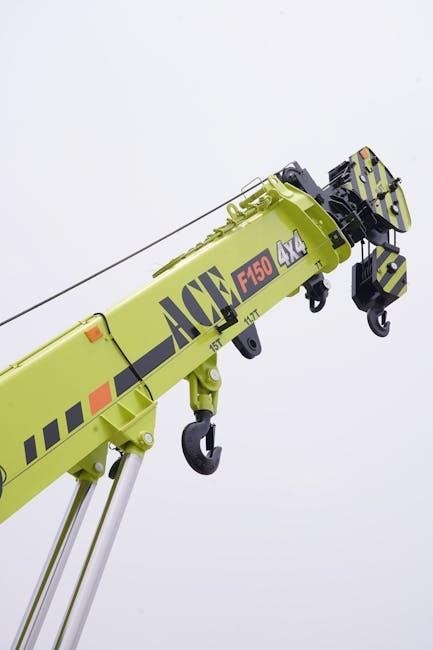survival of the sickest book pdf
Category : PDF
Survival of the Sickest by Dr. Sharon Moalem explores how certain genetic traits linked to diseases once offered evolutionary advantages, reshaping our understanding of health and survival.
Author and Background
Dr. Sharon Moalem, a renowned medical researcher and geneticist, challenges conventional views on disease in her groundbreaking book. With a background in evolutionary biology, she explores how certain genetic traits linked to illnesses once provided survival advantages. Her unique perspective stems from extensive research into human genetics and evolutionary medicine. Moalem’s work has garnered widespread attention, making her a prominent voice in the field of evolutionary health. The book, first published in 2007, became a New York Times Bestseller, solidifying her reputation as a visionary thinker. Moalem’s expertise in genetics and her ability to connect historical evolutionary processes to modern health issues make her a compelling author. Her insights have reshaped how scientists and the public perceive the role of disease in human history.

Main Thesis and Key Arguments
Dr. Sharon Moalem’s Survival of the Sickest posits that many genetic disorders and diseases, often viewed as detrimental, were once advantageous for human survival. She argues that certain traits, such as those linked to sickle cell anemia, hemochromatosis, and other conditions, provided evolutionary benefits in specific environments. Moalem contends that these traits were selected for because they offered protection against ancient threats like malaria or iron deficiencies. Her key argument challenges the traditional view of disease as purely negative, instead framing it as a complex interplay between genetic adaptation and environmental pressures. By tracing these connections, Moalem offers a radical perspective on why certain diseases persist, emphasizing their historical role in enhancing human resilience and survival. This thesis reframes our understanding of health and illness through an evolutionary lens.

Key Concepts Explored in the Book
The book examines how genetic traits, iron biology, and diseases like sickle cell anemia and hemochromatosis played roles in human evolution and survival historically.

The Role of Iron in Human Biology
Iron is crucial for oxygen transport and energy production in cells. The book highlights how iron metabolism has evolved to balance its essential roles against toxicity risks, influencing disease resistance and survival mechanisms throughout human history. Proper iron regulation is vital for immune function and preventing conditions like anemia or overload, which can lead to serious health issues. Dr. Moalem discusses how evolutionary pressures shaped iron-related genetic traits, such as those offering resistance to infections, while also linking excessive iron storage to diseases like hemochromatosis. This duality underscores iron’s central role in both health and disease, making it a key focus of the book’s exploration of evolutionary medicine.
Genetic Traits and Their Evolutionary Benefits
Genetic traits often linked to modern diseases once provided significant survival advantages. For instance, the sickle cell trait, while causing sickle cell anemia in homozygous individuals, offers resistance to malaria in heterozygotes. Similarly, traits like cystic fibrosis may have protected against cholera or other diarrheal diseases. These traits were favored in ancestral environments where such pathogens posed significant threats. The book explains how natural selection shaped these genetic variations, emphasizing their historical benefits over current drawbacks. This perspective challenges the notion that all genetic diseases are purely detrimental, highlighting their adaptive origins and the trade-offs inherent in evolution. By understanding these traits’ historical roles, we gain insights into the complex interplay between genes, environment, and human health.
Disease as a Survival Mechanism
Diseases, often viewed as harmful, have historically served as survival mechanisms. Certain genetic disorders, such as sickle cell anemia, provided resistance to malaria, a deadly disease in ancestral environments. Similarly, conditions like cystic fibrosis may have offered protection against cholera or other pathogens. These traits were selected for in populations where the benefits of resistance outweighed the drawbacks of the disease. The book highlights how such genetic adaptations were crucial for survival in the past, even if they now manifest as debilitating conditions in modern times. This perspective reframes diseases as evolutionary strategies, emphasizing their role in human resilience rather than purely as maladaptations.
Evolutionary Perspectives on Health and Disease
Evolution shapes health and disease through genetic trade-offs, where past survival advantages become modern liabilities, offering a new perspective on our biological paradoxes.

How Evolution Shapes Genetic Traits
Dr. Sharon Moalem explains that genetic traits are shaped by evolutionary pressures, where certain genes that once conferred survival advantages may now lead to diseases. For instance, traits like sickle cell anemia provided resistance to malaria in ancestral environments but cause health issues today. This trade-off highlights how evolution prioritizes immediate survival over long-term health. By examining these genetic adaptations, Moalem reveals how our bodies are a result of historical selective pressures, illustrating the complex interplay between past and present in shaping human biology. This perspective challenges conventional views of disease, emphasizing that many conditions are not random but are deeply rooted in our evolutionary history.
The Trade-off Between Survival and Health
Dr. Sharon Moalem discusses how evolutionary trade-offs often prioritize survival over long-term health. Certain genetic traits, such as those linked to iron regulation, once provided survival benefits but now contribute to diseases like hemochromatosis. Similarly, traits that protected against infectious diseases in the past may lead to chronic conditions today. This trade-off reflects the body’s adaptive strategies, where immediate survival is favored over future health risks. Moalem argues that understanding these compromises is crucial for rethinking disease treatment and prevention, emphasizing that many illnesses are not mere malfunctions but evolutionary remnants of survival strategies. This perspective offers a new lens through which to view health and disease, blending evolutionary biology with modern medicine.
Specific Examples from the Book
The book highlights cases like sickle cell anemia, which reduces malaria risk, and hemochromatosis, linking iron overload to past survival benefits, illustrating evolutionary trade-offs.

Sickle Cell Anemia and Malaria Resistance
The book provides a compelling example of sickle cell anemia, a genetic disorder causing malformed red blood cells. While debilitating in its homozygous form, the heterozygous trait offers malaria resistance, a historical survival advantage in malaria-prone regions. This trade-off highlights how harmful mutations can persist due to evolutionary benefits. Dr. Moalem explains that the sickle cell gene became prevalent in areas where malaria was rampant, as carriers were more likely to survive and reproduce. This example underscores the idea that diseases often emerge from genetic traits that once enhanced survival, illustrating the complex interplay between genetics, environment, and health. Such examples challenge traditional views of disease as purely negative, revealing their evolutionary roots and adaptive roles.
Hemochromatosis and Iron Overload
The book examines hemochromatosis, a genetic disorder causing excessive iron absorption, leading to potential organ damage. Dr. Moalem highlights its evolutionary roots, suggesting it conferred survival advantages in iron-scarce environments. Historically, individuals with this trait could better withstand iron deficiency, a common issue in diets lacking red meat. However, in modern diets rich in iron, this trait becomes problematic, causing iron overload. This duality illustrates how genetic adaptations once beneficial can become detrimental due to environmental changes. Moalem uses this example to emphasize the delicate balance between genetic traits and their surroundings, showing how evolutionary pressures shape health and disease in complex ways. This perspective challenges traditional views of genetic disorders as purely negative, revealing their historical utility.

The Book’s Reception and Impact

Survival of the Sickest became a New York Times Bestseller, praised for its groundbreaking perspective on disease and evolution; It sparked widespread scientific and public interest, reshaping views on health and genetics. The book’s engaging style made complex concepts accessible, appealing to both experts and general readers. Its success lies in challenging conventional wisdom about illness, offering a fresh, evolutionary lens to understand human biology and disease. This impact has made it a influential work in the field of evolutionary medicine, inspiring further research and public discourse on the role of genetics in health and survival.
Publication and Popularity
Survival of the Sickest was first published in 2007 by HarperCollins and quickly gained recognition as a New York Times Bestseller. Its engaging narrative and revolutionary ideas captivated readers, making it a popular choice among both scientists and the general public. The book’s availability in multiple formats, including PDF, Kindle, and audiobook, contributed to its widespread accessibility. Dr. Sharon Moalem’s unique perspective on disease and evolution resonated globally, sparking discussions in scientific communities and beyond. Its success led to translations and adaptations, further expanding its reach. The book’s popularity endures, remaining a key text in the field of evolutionary medicine and a testament to its impactful storytelling.
Scientific and Public Reception
Survival of the Sickest received widespread acclaim for its innovative approach to understanding disease and evolution. The scientific community praised Dr. Sharon Moalem’s meticulous research and ability to present complex concepts in an accessible manner. Public reception was equally enthusiastic, with readers appreciating the book’s engaging storytelling and thought-provoking ideas. It has been recognized as a groundbreaking work in evolutionary medicine, offering fresh insights into how genetic traits once beneficial for survival can become liabilities in modern times. Both scholars and the general public have embraced the book, making it a significant contribution to the field while sparking broader discussions about health and biology.
Practical Implications of the Book’s Ideas
The book challenges traditional medical approaches by revealing how evolutionary insights can improve disease prevention and treatment, offering a new perspective on human health and genetics.
Understanding the Role of Disease in Evolution
The book reveals that certain diseases are not mere medical anomalies but remnants of evolutionary adaptations that once conferred survival advantages. For instance, sickle cell anemia, while debilitating, provided resistance to malaria in ancestral environments. Similarly, conditions like hemochromatosis, which leads to iron overload, may have evolved to aid survival in iron-scarce regions. By tracing the evolutionary origins of such traits, the book offers a fresh perspective on why certain diseases persist. This understanding challenges the traditional view of disease as purely negative, instead highlighting its role in human adaptation. Dr. Moalem argues that recognizing this evolutionary context can lead to more effective medical treatments and a deeper appreciation of the complex interplay between genes, environment, and health.
Modern Applications of Evolutionary Medicine
Dr. Sharon Moalem’s insights in Survival of the Sickest have profound implications for modern medicine. By understanding the evolutionary roots of diseases, researchers can develop targeted treatments that consider the historical context of genetic traits. For example, studying how certain conditions like hemochromatosis evolved to aid survival in iron-deficient environments informs new approaches to managing iron-related disorders. This perspective also highlights the importance of personalized medicine, where treatments are tailored to an individual’s genetic makeup and ancestral background. Additionally, evolutionary medicine encourages a shift from viewing diseases as purely negative to seeing them as remnants of adaptive strategies, fostering innovative approaches to prevention and therapy. This framework is reshaping how scientists and clinicians tackle health challenges in the modern world.

Formats and Accessibility
Survival of the Sickest is available in various formats, including PDF, Kindle, and audiobook, ensuring accessibility for readers with diverse preferences and needs.
PDF and Digital Versions
The Survival of the Sickest book is widely available in PDF and digital formats, making it accessible to a broad audience. Readers can download the PDF version for free or purchase it through platforms like Amazon and Google Books. Additionally, the book is offered in Kindle and EPUB formats, ensuring compatibility with various e-readers and devices. The digital versions allow for easy navigation, highlighting, and note-taking, enhancing the reading experience. Many websites provide direct links to download the PDF, while others offer the option to read it online. This accessibility has made the book a popular choice among those interested in evolutionary medicine and genetic traits. The digital formats have also contributed to its widespread popularity, catering to modern readers who prefer convenience and portability.
Audiobook and Other Formats

The audiobook version of Survival of the Sickest is narrated by Jonathan Prince and Eric Conger, offering an engaging listening experience. It is available on platforms like Audible, Google Play Books, and Apple Books. Additionally, the book can be accessed in various digital formats, including Kindle and EPUB, ensuring compatibility with different devices; The audiobook provides a convenient way for readers to explore Dr. Sharon Moalem’s groundbreaking ideas on evolutionary medicine. Its availability across multiple platforms makes it accessible to a wide audience, catering to those who prefer listening to reading. The audiobook has garnered positive reviews for its clear narration and the insightful perspective it offers on the role of disease in human evolution.
Survival of the Sickest by Dr. Sharon Moalem offers a provocative and insightful exploration of the interconnectedness of disease and human evolution. By challenging conventional views, Moalem reveals how certain genetic traits, once beneficial for survival, now manifest as diseases. The book underscores the delicate balance between health and evolutionary adaptation, providing a fresh perspective on why some conditions persist. Moalem’s engaging narrative and scientific rigor make the book accessible to both experts and general readers. Ultimately, Survival of the Sickest reshapes our understanding of human biology and encourages a deeper appreciation for the complex interplay between genes, environment, and disease. It leaves readers with a newfound respect for the resilience of the human body and the wisdom of evolutionary processes.


























































































